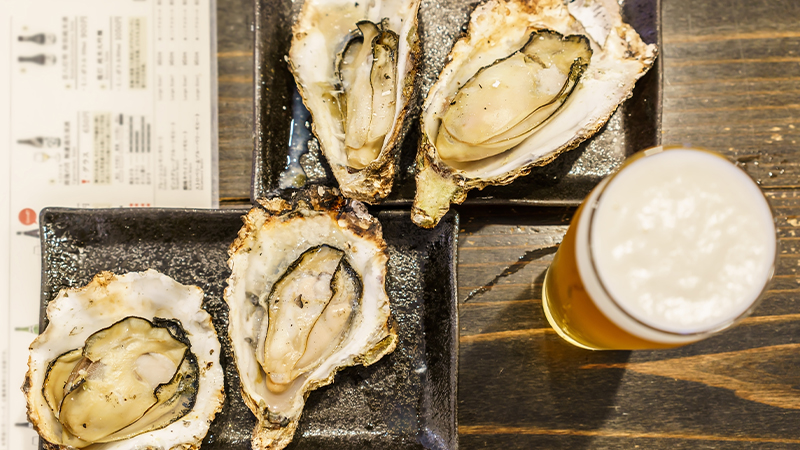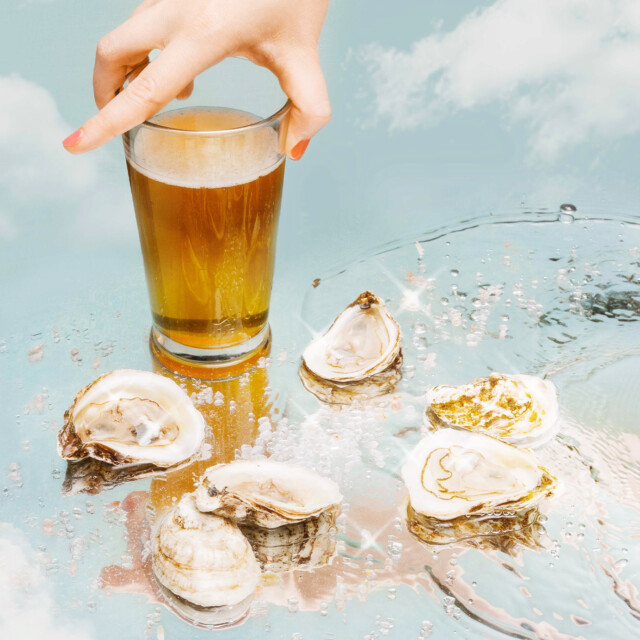For years, oysters have seemingly been the perfect pairing for myriad grape-based drinks and spirits. Oysters and Champagne? It’s a party. Oysters and rosé? Summer perfection. Oysters and Sauvignon Blanc? Classic. Oysters and a Martini? Mr. Gatsby’s in the house.
But there is another category of adult beverage out there that shouldn’t be overlooked when it comes to creating stunning flavor pairings with salty, briny oysters: beer.
The best thing about beer, says Bryan Long, director of food and beverage at the Eau Palm Beach Resort + Spa, based in Manalapan, Fla., is that there are so many different styles, each of which can pair up beautifully with various types of oysters. Looking for something traditional? There is a beer for that. Want your taste buds to explode during this pairing? There is a beer that can make that happen, too.

“A briny, salty oyster with the right beer can cut right through the saltiness to provide a more balanced flavor on both ends,” says Nick Baitzel, director of operations at Philadelphia-based Sojourn Resturants.
Oysters 101
To truly understand how to pair oysters with beer, understanding oysters is the first step. Paul McCormick, owner of Great Gun Oysters, grows his bivalves out of Moriches Bay on Long Island. He explains that oysters tend to change flavor throughout the season — October to early April being the best time to shuck and slurp them — which is something to keep in mind when you’re looking to create your perfect pairing.
“Keep in mind that oysters are savory, salty, and sweet for the most part. They don’t usually have a sharp (bitter) or sour taste, which can help when deciding what beer to drink alongside them,” he explains. You can expect oysters to start salty upfront, then sweet and creamy on the back of the palate. However, the nuances of flavor differ based on location. McCormick says doing a bit of research about specific oysters or knowing the dominant flavor profile of your favorites will help, too. Great Gun posts information about the harvest on its website, so consumers can understand what type of flavor profile they’re getting based on farm location and time of year.
If you prefer more savory flavors to salty and briny ones, there is a trick to brightening up those flavors any time of the year, says Chris Quartuccio, founder of Blue Island Oysters off the coast of Long Island, N.Y. He suggests pouring the water out of the shells and then allowing them to sit for a few moments. This will bring out notes you might have never expected from an oyster and may also impact your drink of choice.
Beer for Beginners
If you’re tepid about this food and beer pairing, there are plenty of ways to dive in without having to go too far out of the realm of what one would expect. In fact, there are several types of beer that mimic the flavors and even effervescence of wine — a great way to ease in and make it a bit less foreign.
However, for Rob Day, vice president for marketing at Jack’s Abby and Springdale Beer Company, oysters and beer are a pairing that’s not foreign at all. The brands are based in Framingham, Mass., right in the middle of a thriving Northeast oyster industry. His advice for beginners here is to first ask your server about the dominant flavor profiles of the oysters being offered and then make a decision from there. Mineral flavors, he says, are the most approachable and may remind a sipper of the classic oyster and Sauvignon Blanc combination.
“If your oysters are mineral-based, you could bridge that with a mineral-style beer. A Czech pilsner and a lot of different lagers have that kind of content,” he says. “You could overpower a mineral-based oyster very quickly, so that’s why I’d go with something complementary.”

Long’s pick for first timers is a traditional saison because of the category’s tight carbonated bubbles, light body, and a hint of spice. This, he says, is the best beer pairing to ease Champagne and oyster lovers into pairing their bivalves with beer.
On the other hand, a dark stout or porter with oysters is Baitzel’s go-to pairing recommendation. “The extra body and mouthfeel can hold up to the sharp flavors of oysters well,” he says.
Walk on the Wild Side
Looking to create a super-unique flavor combination with your bivalves and beer of choice? There are plenty of options here, too. Long notes that the more complex they are, the more fun you can have with these brews and bites. “If you have a super-briny oyster, a sweeter style beer would pair nicely if you like sweet and spicy,” Baitzel says. “If you’re working with a creamier-style oyster, you would want something more tart and funky beer such as a Berliner weissbier or gose. If you want to take it to another level, Michelada oyster shooters are the way to go.”
Baitzel says his favorite oyster and beer pairing is a sour or gose-style beer, as their natural sweet and sour notes tend to pair well with the bold flavors of oysters — but he warns to stay away from fruit sours, as their acidity may be overpowering.
Day, on the other hand, inspires people to take a chance on some pairings that may sound completely off base but will actually provide a flavor blast. “When you get more extreme flavors, it’s nice to do a contrast instead of a complement because what that allows you to do is mute different flavors in the beer and accentuate others,” he says. Day breaks it down this way: When you eat a piece of heavy, dark chocolate and then have a raspberry, the latter’s tart, puckering flavors are tamed. The same flavor theory goes for bivalves and brews. “If you have a heavy brine and you want to taste that and accentuate it, go with that smoked stout. You’ll bring out cool flavors in that beer and cool flavors in the oyster that you might not have perceived otherwise,” he explains.
But when all else fails, Long encourages a bit of experimentation while sipping and slurping. Order up a dozen (or two!) oysters and a flight of craft beer, then mix and match to find your new go-to pairing.
